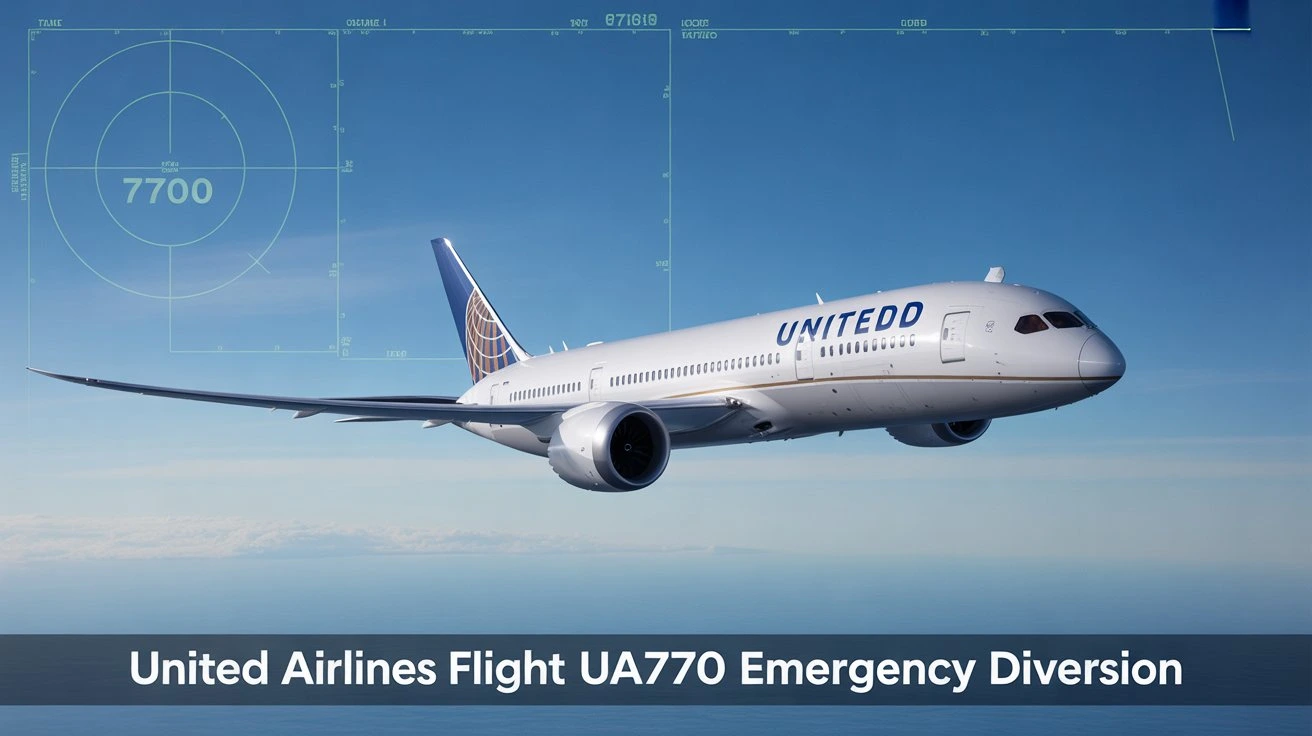United Airlines Flight UA770 emergency diversion has raised many questions among travelers, aviation enthusiasts, and media alike. When an aircraft bound from Barcelona to Chicago on May 27, 2025, encountered what appeared to be an anomaly with the cabin pressurization system, the crew declared an emergency and diverted to London Heathrow. This article explores in detail what the phrase “United Airlines Flight UA770 emergency diversion” means, why it matters, what exactly happened, and what we can learn from it. Understanding this helps passengers feel more informed and reassured about airline safety.
What is the United Airlines Flight UA770 Emergency Diversion
“United Airlines Flight UA770 emergency diversion” refers to a case in which UA770, a long-haul flight, was compelled to change its destination mid-air because of safety concerns. In this specific incident, the crew detected a possible issue in the aircraft’s cabin pressurization system. This triggered protocols where safety overrides the original flight plan. The plane landed safely at a different airport than planned, in order to ensure passenger well-being and aircraft integrity.
This kind of diversion isn’t common, but it’s an important part of commercial aviation safety. Airlines have procedures and systems designed for such events, and they are carried out under strict regulations. The term “emergency diversion” does not necessarily mean there is imminent danger, but that enough concern exists to justify rerouting for precaution and safety.
Why the Topic Matters
For passengers, such an event can feel alarming: change of landing point, delays, missed connections, and uncertainty. But from a broader perspective, the UA770 diversion illustrates just how far airline safety, technology, and crew training have evolved. It shows that modern aircraft systems can detect issues early, that crews are prepared to act, and that regulators and airlines put safety ahead of convenience.
People who fly long distances, who care about aviation news, or who work in safety regulation will find this especially relevant. Also, those curious about how airlines handle in-flight emergencies will gain insight here. In an era when any flight irregularity tends to spread swiftly through social media, understanding what really happens can reduce misinterpretation and panic.
Real-World Account of UA770 Emergency Diversion
UA770 was operating from Barcelona El Prat Airport bound for Chicago O’Hare on a Boeing 787-9 Dreamliner. Approximately ninety minutes after takeoff, while at cruising altitude, pilots detected a potential fault in the pressurization system. Though no rapid depressurization occurred, the warning was enough to caution the crew. They declared an emergency, issued the standard transponder code squawk 7700, which signals a general emergency to air traffic control and other relevant authorities. The decision was made to divert the flight to London Heathrow.
At Heathrow the technical inspection and passenger care operations proceeded, and no injuries or oxygen-related incidents were reported. Passengers were then supported with rebooking, accommodation if required, and updates from United. The event is seen as precautionary rather than a crisis in which harm occurred.
Benefits of Such Emergency Diversions
One might wonder what the upside is when flights are disrupted. The UA770 case shows multiple benefits, even though it was inconvenient.
Firstly, safety is preserved. When there is any concern — however small — about critical systems like pressurization, taking action early reduces risk. Secondly, these diversions test and prove airline protocols, crew ability, and airport readiness. Real-life situations provide feedback that helps refine training, maintenance processes, and emergency response structures. Thirdly, passenger trust. While the event causes stress, how it is handled can build confidence in the company. In UA770’s case, many passengers expressed relief at the crew’s communication and professionalism. Fourthly, regulatory compliance. Airlines must abide by international safety laws. Responding appropriately to alerts ensures compliance and avoids worse outcomes down the road.
Challenges & Drawbacks
These diversions also bring challenges. For the airline, there are operational costs: fuel, handling at unscheduled airports, crew duty limits, costs of lodging and meals for passengers. Scheduling ripple effects occur: subsequent flights, crew rest periods, aircraft availability all get disrupted.
For passengers, the difficulties are obvious: delays, sometimes overnight stays, disrupted connections, loss of time, added stress. Some may have non-refundable accommodations, meetings, or other plans in their destination city that get affected.
Another challenge is communication. Passengers often get only limited information when something goes wrong, which can foster rumors or anxiety. Transparency, while maintaining clarity about what is known versus still under investigation, is crucial. Finally, investigations take time. The root cause (sensor failure, system miscalibration, etc.) may not be immediately obvious.
How Safety Protocols Work: Step-by-Step Guide to an In-Flight Divergence Decision
Even though each incident has its differences, UA770 highlights a typical process of how airlines respond. Understanding this helps demystify what goes on behind the scenes.
The process begins with monitoring. Aircraft constantly monitor systems like pressurization, hydraulics, engines, cabin altitude, warnings or alarms. If a system warning appears, the flight crew assesses its severity. They refer to onboard diagnostics and the aircraft’s manuals.
If the warning is significant enough, the pilot in command will decide whether to declare an emergency (often with squawk 7700) and request diversion. The crew coordinates with Air Traffic Control (ATC) to identify the nearest safe and equipped airport. They must ensure fuel sufficiency, runway length, emergency services, and facilities are adequate.
Simultaneously, cabin crew begin communicating with passengers, calming them, explaining what is known, and preparing the cabin for possible unscheduled landing. Ground operations (from the airline’s control center) start preparing: notifying destination airport, arranging passenger support (hotels, meals), arranging for a spare aircraft if needed.
Once diverted, the plane lands, emergency services are on standby if required, maintenance inspections commence immediately, and passengers are taken care of. Afterwards, there is a formal incident report and investigations to find root cause and ensure corrective actions.
Technical Aspects: Pressurization & “Squawk 7700”
One of the two key technical issues in UA770 was the alleged anomaly in the pressurization system. Aircraft flying at high altitude require atmospheric pressure inside the cabin that mimics lower altitudes so passengers can breathe comfortably. If that system shows signs of failure or abnormal readings, it can threaten oxygen levels or cause discomfort, which in severe cases may lead to hypoxia (lack of oxygen). Although UA770 did not suffer decompression, the alert triggered precaution.
“Squawk 7700” is a universal transponder code used in case of a general emergency. When a pilot sets this, ATC is informed immediately of the emergency status, and the flight is given priority and expedited handling. This code is visible to controllers and sometimes to other aircraft, and opens up emergency channels of communication, ground preparation, and technical inspection. Its use in UA770 shows standard procedure was followed.
Impact & Aftermath
After the diversion to Heathrow, United Airlines deployed its emergency ground procedures. Technical teams inspected the pressurization system and associated sensors. Passengers were rebooked, transported to hotels where needed, given meals, and updates. Connections were rescheduled. United made public statements emphasizing safety and no harm to passengers. News coverage was cautious, focusing on safety protocols rather than sensationalizing fear. Aviation analysts have used UA770 as a case study in successful emergency response. Regulators will review the flight’s data to ensure standards were met.
Lessons and Takeaways
The UA770 emergency diversion underscores several lessons. Safety protocols aren’t optional — they’re working systems that save lives and prevent escalation. Crew calmness and clear passenger communication matter immensely. Early detection of possible system issues can prevent more serious problems. Airports with strong emergency infrastructure are indispensable. Transparency in handling such events sets a standard for public trust. As aircraft become more advanced, the systems that monitor those aircraft, and the people who respond, become more important.
Frequently Asked Questions
What triggered the United Airlines Flight UA770 emergency diversion?
An anomaly in the aircraft’s cabin pressurization system was detected during cruise, prompting precautionary action by the flight crew.
What does “squawk 7700” mean?
It is a transponder code that signals a general airborne emergency, granting priority clearance and emergency support from air traffic control.
Was cabin pressure lost or did oxygen masks deploy on UA770?
No, there was no full decompression, and oxygen masks were not reported as deployed; it was a potential system issue rather than an acute failure.
Were any passengers or crew injured?
No injuries were reported. All onboard were safely disembarked.
Why was Heathrow chosen as the diversion airport?
Heathrow was close to the aircraft’s flight path, has advanced technical, emergency, and ground support infrastructure, and is a major international hub equipped to handle such emergencies.
Will this affect United Airlines’ safety rating?
Likely not negatively; these events are part of how safety is maintained. Response effectiveness, communication, adherence to protocols strengthen, rather than diminish, credibility when handled properly.
Also visit for more: gradskiprevozuzice
Conclusion
United Airlines Flight UA770 emergency diversion is not just a news item — it is a demonstration that aviation safety systems, crew training, and emergency response mechanisms are strong, and that passenger safety is the priority. While diversions cause inconvenience, they are often precautionary, not catastrophic. If you fly often, knowing what terms like diversion, squawk 7700, and pressurization alert mean can help you stay calm during unexpected events.
If you found this explanation useful, share it with people you fly with. Sign up for alerts from your preferred airlines for flight status updates, and consider reading more about aviation safety — because the more people understand, the less fearful flying becomes.


